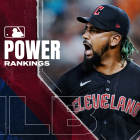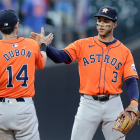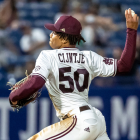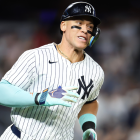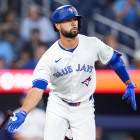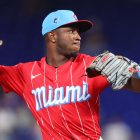
Major League Baseball, like many sports leagues around the world, has been shut down indefinitely because of the growing threat that is the novel coronavirus (COVID-19). Spring training has been suspended since March 12 and Opening Day has been pushed back to at least mid-May, and that remains subject to change as the situation develops.
MLB and the MLBPA recently resolved several important shutdown-related issues, among them the annual amateur draft. With no games being played, there is nothing to generate revenue, and MLB wanted to make cuts to the draft to ease their anticipated cash flow problems. Here are the changes made to the 2020 draft:
- The draft can be held as early as June 10, the original start date, or pushed back as late as July 20. The signing deadline will be no later than Aug. 1.
- MLB can cut the draft from 40 rounds to as few as five, and bonus pool figures will remain the same as 2019. Typically there is a 3-5 percent raise each year.
- Players will receive $100,000 upfront. The rest of their signing bonus will be paid in two equal installments on July 1 each of the next two years.
- Undrafted free agents will have their bonuses capped at $20,000. Previously they could receive up to $125,000 before counting against their team's bonus pool.
Most of the same rules apply in 2021 as well. MLB can cut the draft to 20 rounds next year (not five) and the bonus pools will again stay at 2019 levels. Bonuses will be deferred in the same way next year and undrafted free agents can not receive more than $20,000. The earliest the draft can go back to normal is 2022.
Some colleges and high schools in warm weather states played a few weeks worth of games prior to the pandemic, but scouts have since been pulled off the road and amateur baseball has been shut down. There are no games and no one to scout them. MLB teams scout draft-eligible prospects years in advance and will have to rely on that old information in this year's draft.
"It really makes it more of a challenge. You haven't seen the player. Did he get stronger? It makes it hard. It's a little bit of a challenge," Yankees scouting director Damon Oppenheimer told George King of the New York Post recently. "Rely on quality information (we already have) and work with that."
According to our R.J. Anderson, scouts will be allowed to contact amateur players this month. MLB recently shut down all scouting operations and prohibited such contact. Teams won't be able to scout players, but they will be able to get to know them, gauge their makeup, their work ethic, and their desire to turn pro, among other things.
Major League Baseball is expected to allow scouts to contact amateur players again beginning next week, per multiple sources. MLB had prohibited that behavior back in mid-March.
— R.J. Anderson (@r_j_anderson) April 1, 2020
Although the draft is the best way to acquire cheap controllable talent, the one thing MLB teams value above all else, MLB has tried to save money through the draft for years now. Amateur players are not members of the union, so the MLBPA has been more than willing to use their rights as a bargaining chip. They did it again this year to get favorable service time terms.
The changes to this year's and next year's draft will have massive long-term ramifications for everyone involved. Players, teams, colleges, coaches, analysts, trainers, baseball at large, so on and so forth. Here's what the changes to the draft, which were spurred on by the pandemic, will mean for baseball going forward.
Mid-range draft prospects will be hurt the most
For the most part, the top 100 or so draft prospects will be fine this year. They'll have to wait two years to get their full bonus, but they will still be drafted, and they'll lock in a life-changing sum of money. The bottom-tier prospects, the guys who receive bonuses as small as $1,000, are still in the same boat as always, only now their $20,000 bonus cap is official policy rather than unspoken.
Last year exactly 100 players received six-figure bonuses in rounds 6-10, and another 293 players received six-figure bonuses in rounds 11-40. Those mid-range prospects, the kids good enough to get a decent payday but not good enough to be selected near the top of the draft, will be the players hurt most by this year's shortened draft. For them, it's now $20,000 or nothing.
Consider the two options a college junior projected to go in rounds 6-10 this summer will have after going undrafted:
- Sign for $20,000 as an undrafted free agent.
- Return to school for your senior year, then reenter the draft as a senior with no leverage next year.
That $20,000 bonus cap for undrafted free agents is at the top end of what the typical college senior receives each year. The vast majority of college seniors sign for $10,000 or less. So, if you're a good college player projected to go in rounds 6-10 this year, your expected $125,000 to $300,000 bonus has become $20,000 regardless of whether you sign this year or next.
There will now be 35 rounds worth of players (plus another 20 rounds next year) left to seek baseball elsewhere. Many will go to college and play baseball, though that creates another set of challenges, which I'll detail in a bit. Some other players will simply take the $20,000 bonus and turn pro, because getting into professional baseball is really hard (and getting harder), and this might be their only opportunity to do so.
And, inevitably, there will be players who would've been drafted this year (but now won't) that will quit baseball entirely. Some will join the workforce because they can't afford to do anything else. Others may focus on another sport, like football, because that's their only path to a college scholarship. MLB has effectively encouraged two-sport high schoolers to go play that other sport.
For multiple reasons, baseball will lose talent this year. Kids will go undrafted and have to give up baseball because it is no longer financially feasible, and that's a shame. Paul Goldschmidt was an eighth-round pick and reigning two-time Cy Young award winner Jacob deGrom was a ninth-round pick. Those long shot success stories will be few and far now.
Colleges will be overwhelmed with talent
For all intents and purposes, MLB clubs are outsourcing player development to colleges. They're drafting and signing the cream of the crop, and will check back in a few years to see how the other kids develop. That sounds good in a vacuum, though college coaches generally prioritizing winning, not development. Pitchers are often overused in college.
The shortened draft ensures more recruits will wind up on campus next year and give college programs the most talent they've had to work with basically ever. So much round 6-40 talent will be college-bound now. The thing is, college roster sizes are not changing to accommodate all the extra players. Here are the NCAA roster limits:
- 35-man rosters
- 11.7 scholarships (some programs don't even fund that money)
- Maximum 27 players on scholarship (the minimum partial scholarship is 25 percent)
The NCAA recently ruled returning seniors will not count against the 35/27 limit in 2021, which provides some roster crunch relief, but not much.
The shortened draft means that not only will a couple hundred players go undrafted this summer, but many will also be squeezed off Division I rosters. The supply of players will far exceed the demand for those players in the draft and in Division I. Many players will have to head to Division II or III, or the NAIA, or a junior college, to continue their careers.
On one hand, the caliber of competition in college baseball should be better than ever the next few years. Junior colleges in particular stand to benefit from the shortened draft. On the other hand, the market has been flooded with talent. More amateur players are competing for fewer draft slots and an unchanged number of college roster spots. Players have had the odds stacked against them even more than usual.
Minor-league franchises will be hurt

The Professional Baseball Agreement (PBA), the contract that binds MLB and the minors, requires MLB teams to provide full minor-league rosters this season. We don't know when the season will begin, but whenever it does, clubs must have enough players. Generally speaking, the late rounds of the draft are used to fill out minor-league rosters. Those rounds no longer exist.
If there is a minor-league season this year -- that is very much up in the air at this point -- teams will have to bring in undrafted free agents (the undrafted players most likely to sign for $20,000 are the lower-tier prospects who were slated to make that anyway) and perhaps scour independent leagues just to meet their roster minimums this summer.
Baseball is in the entertainment business and the minor-league product will suffer as a result of these draft changes because many quality players, those rounds 6-10 guys, are being encouraged to go to college. Is this even good for development? How will, say, 2019 No. 1 pick Adley Rutschman develop when he's not being challenged as much as he would with a full draft?
There's also this: minor-league franchises are essentially small businesses. Many are independently owned and operated and they have roughly 70 home games a year to make money, plus a few postseason dates if they're lucky. Those franchises are already dealing with cash flow problems and several won't survive the pandemic. They are not dissimilar to restaurants and other small businesses.
For MLB, this is a feature, not a bug. MLB wants to eliminate 42 minor-league teams as soon as 2021, and, in 5-10 years (maybe fewer), I think we'll be able to draw a straight line from this year's draft changes to a couple dozen minor-league teams closing up shop. The pandemic is hurting minor-league clubs financially and shortening the draft makes it more difficult to field full rosters at every level. The wheels have been put in motion.
Minor-league franchises have to worry not only about their business remaining viable through the pandemic, but fielding a quality roster should the season begin. There are now 35 rounds worth of talent being encouraged to go to college, so, even if games do get played this year, the rosters won't feature as many recognizable names. MLB's minor-league contraction plan is that much closer to reality.
The road to an international draft has been paved
As part of the MLB-MLBPA agreement, MLB can push the start of the 2020-21 and 2021-22 international signing periods back six months. The international signing period (i.e. when teams can sign amateurs from Latin America, Asia, and the rest of the world) runs from July 2 to June 15 each year, so MLB can push the 2020-21 period back to January 2021, and the 2021-22 period back to January 2022.
On the surface, this is not a big deal. The players will have to wait a little longer to get their bonuses, which is a bummer, but they will get them soon enough (international bonuses will not be deferred like draft bonuses). More than anything, shifting the start of the international signing period back to the offseason and fitting it neatly within a calendar year appears to be a proactive logistical move designed make an international draft more feasible.
MLB, much like shortening the draft and trimming the minors, has eyed an international draft as a way to cuts costs for years now. They successfully implemented a bonus cap not too long ago -- again, the MLBPA was happy to negotiate away the rights of amateur players to get other concessions -- and now they're looking to take another bite. An offseason draft allows players to begin their careers that year rather than sign in July and wait until the following year, like the current system.
Clubs already have verbal agreements in place with some 2021-22 signing period prospects (yes, they've promised money to 14 and 15-year-old kids), so it would seem 2023 is the earliest an international draft could be put in place. The current Collective Bargaining Agreement expires in Dec. 2021, so teams would have 2022 under the current international system, then the draft begins in 2023. That's a possible timeline.
Similar to the draft and the minor-league contract plan, I think we'll be able to draw a straight line from this year's international signing period changes to an international draft when it's all said and done. MLB has been pushing for it, and now they have the ability to unilaterally make it more feasible by moving the signing period start date to a convenient time for an international draft.
The Carter Stewart option
Last year Carter Stewart, the No. 8 pick in the 2018 draft, signed an unprecedented six-year contract worth more than $7 million with the Fukuoka SoftBank Hawks in Japan. He opted not to sign with the Braves as a drafted player after the club found a wrist issue during his physical and slashed their bonus offer, and after a year in junior college, Stewart headed to Japan.
If nothing else, more amateur players could pursue the Stewart route, which ensures them a nice payday and a chance to become a free agent at a young age (Stewart will be a free agent at 25). It's easier said than done -- Stewart was an elite prospect and it takes two to tango (a team has to be willing to sign the player) -- but we now know it's possible. Stewart's shown it can be done.
MLB absolutely should not lose top amateur talent to Japan (or Korea) for financial reasons. They should want to get those players into their pipeline and into the big leagues as soon as possible. Now, because being drafted will be that much more difficult, more good young players could head overseas. It's hard to see how that is good for MLB overall.
Despite their efforts to grow the game globally (World Baseball Classic, playing overseas, etc.), Major League Baseball is not very good at encouraging amateurs to play their sport. They're pushing kids to college, maybe even overseas, and maybe even to other sports entirely. In the short-term, MLB will save money, which will help during the pandemic. There will be a real long-term cost, however, when the future talent pool is not as robust as it would be with a longer draft and true international free agency.
MLB has been looking to cut costs associated with the draft, the minor leagues, and international free agency for years. Decades, even, and they've successfully leveraged the COVID-19 pandemic into a shorter draft (guaranteed savings now) and paved the way for their minor-league contract plan and an international draft to become reality (more savings down the road). There is little reason to believe the draft and international free agency will go back to normal in two years, and it's shortsighted. MLB is taking $1 today rather than $2 tomorrow, which is both par for the course and bad for baseball long-term.










